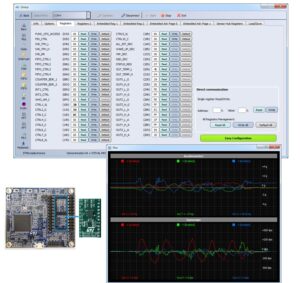To improve the accessibility of our content, please find the audio version of this blog post.
On October 21, 2020, the ST Blog will host its first virtual roundtable with design houses. After interviewing Siana Systems in preparation for this event, we sat down with Synapse, the other member of the ST Partner Program that will participate in the discussion. The roundtable will take place during the ST Virtual Developers Conference. Since 2016, the event brings customers, enthusiasts, and industry leaders together to make innovations and expertise more accessible. Moreover, it was during such an event that we first launched the ST Partner Program in 2017. The upcoming roundtable is, therefore, highly symbolic for two reasons. It is a celebration of what the ST Developers Conference represents and a testimony of how far the Partner Program has come.
The Neurons at Synapse
To learn more about Synapse, we approached Jake Sprouse, Head of Technology at the company. He explained that his teams focus on end-to-end development. For instance, customers can go to Synapse to get expertise on technology feasibility or manufacturing hand-off. Put simply, the 175 employees, 80% of whom are engineers, work on IoT front end and back-end consultancy. They also ensure that clients end up owning all the technologies built in the process.
It was humbling to hear Jake explain that at its core, Synapse is “technology-agnostic.” The company does not have an allegiance to a particular maker. Hence, his teams only use ST’s devices if they believe we have the best solutions to a problem. Additionally, their choice of components goes beyond a data sheet to include a manufacturer’s ability to work with them. As a result, our close partnership also plays a vital role in their choice to use our components. Synapse roots this agnosticism in its desire to help clients realize their vision while managing their risks.
Synapse, When a Vision Leads to a Wearable Innovation
A Vision-Led Process
Jake explained that Synapse focuses primarily on a customer’s vision. Too often, engineers start a project by drafting a list of specifications and work from there. Synapse is different. The company first understands what the customer is trying to accomplish and what overarching problems to solve. Jake told us that,
“Synapse offers the most value when customers don’t have all the answers and don’t know exactly how to get what they want. The best way to approach a project with us is to understand it in terms of vision validation. Synapse can offer price estimates based on past projects, but our teams work best when clients can take a longer view.”
Nike+ FuelBand
This vision-centric approach of engineering pushes Synapse to work on groundbreaking products, like the Nike+ FuelBand. The wearable, released in 2012, was unique at the time. Synapse first helped Nike focus on its vision, meaning a flexible wristband with a display and an embedded system. The design house then outlined some of the biggest design challenges to realize this vision. For instance, the use of a flexible circuit could negatively impact components. Similarly, no one knew at the time if the sensors would function properly after the over-molding process. Working closely with ST helped Synapse find solutions for each of these issues and ultimately release an innovative design.
How to Prepare for the Next Vision?

As Jake shared, every product development is different, but a common thread is the importance of laying meaningful groundwork. To be able to prioritize a vision, engineers must already have foundational technologies on hand. For instance, Synapse worked on developing haptic systems because it realized it was difficult to find off-the-shelf solutions. Similarly, they have a code repository for STM32 to prototype rapidly with specific features. The design house even has various STM32CubeMX projects at the ready to hit the ground running. Focusing on vision starts before a customer even formulates it, which is why Jake’s teams spend so much time with ST development boards and tools.
Synapse, When Risk Assessment Leads to New Industrial Applications
Risk assessment
Prioritizing the customer’s vision has a lot of merits, and it can be gratifying. On the other hand, design houses can get into trouble if they don’t correctly assess risks. It’s the reason why Synapse strongly emphasizes the importance of transparency. Indeed, one must define a vision as well as realistic expectations. As a result, assessing risks starts with extensive prototyping work. Figuring out if a machine learning algorithm will work demands precise and qualitative data collection. Similarly, determining whether a manufacturing process is viable at a large scale starts with building lots of mockups. As Jake explained,
“Many of our projects start as a proof-of-concept on an STM32 Nucleo board. Managing risk is far simpler when you start by using the demo applications and tools at your disposal. My advice would be to avoid customizing systems too early. Building a quick mockup from boards and software already available is far more efficient.”
Creating the First Smart Motor Brush for a Hydro Plant
Synapse shared a personal story about a customer that wanted to develop IoT sensors for carbon brushes in a power generation plant. After working on the vision, the design house assessed the risk, which was high in this instance. Indeed, the operating conditions were harsh, the industrial requirements were stringent, and finding a Bluetooth radio would, therefore, prove challenging. However, thanks to their close relationship with ST, Synape’s engineers were able to develop a prototype. One determining factor was that we had the only Bluetooth LE module in the industry capable of withstanding high enough temperatures. Ultimately, Synapse could use our development tool and devices to assess risk and realize their client’s vision.
How to Overcome the Next Challenge?
Jake has two pieces of advice for engineers getting ready to face their next challenge. The first one is to use tools that reduce friction and lower the need for specialized competency. For instance, by using ST’s Unico GUI, an electrical engineer at Synapse can undertake a lot of the work that previously required a software developer. The ST utility vastly simplifies workflows and algorithm configurations. By prototyping fast, companies can assess risk better and clearly outline their client’s vision.
The second piece of advice from Jake was to question common assumptions. For instance, many engineers want GUIs, and Synapse was glad to tell us that they often use the TouchGFX framework. However, the company also has a thought-provoking blog post on Physical User Interfaces that challenges current trends. In its paper, Synapse argues for the importance of thoughtful button placements and the intuitiveness of manual interactions. Reactive physical control interfaces (RPCI) can offer users a great experience and differentiate products from the competition. Engineers working on embedded systems ought, therefore, to consider physical interactions very carefully, instead of merely relying on graphics.
- Learn more about Synapse
- Register for the Roundtable
- Attend the Virtual ST Developers Conference
